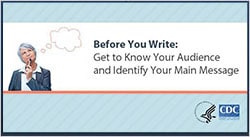Before You Write: Get to Know Your Audience and Identify Your Main Message

In this module, you’ll get answers to key questions like:
- How can I target the right audience with my writing?
- What are consumer audiences looking for — and how can I provide it?
- How can I make my writing for professionals clearer and more effective?
- Are “clear communication principles” just a nice way of saying I should dumb down my work?
After you take this course, you’ll be better able to:
- Understand the legal — and ethical — importance of using clear communication
- Target your writing to meet the needs of specific audiences
- Identify the purpose and main message of your document
- Make your writing actionable, so users know what to do after reading it
Remember that clear communication is the law. The 2010 Plain Writing Act requires that federal agencies use plain language in documents for consumers. But clear writing isn’t just a legal obligation. It’s an ethical one, too. Why?
- 1 out of 2 people struggle with reading
- 9 out of 10 people have difficulty with health literacy
By getting to know your audience and using clear writing, you’ll reach more people with your message. You’re overcoming barriers — language issues, literacy, level of education — and getting people key information they need to protect their health.
Source: Health literacy basics (n.d.). Retrieved September, 8, 2014, from https://health.gov/communication/literacy/quickguide/factsbasic.htm
Let’s say you’re working on a new project about an environmental health issue. But who’s it for?
- A colleague?
- A health professional, like a doctor or toxicologist?
- A worried mother?
Your intended audience matters. Your audience shapes not just how but what you write. That’s why it’s essential that you have a specific audience in mind before you start writing.
Look at the images below to find out who these people are and what they want to know.








Your target audiences aren’t just looking for information. People want to know what they need to do. So help your readers by always giving suggestions that they can act on.
Some pressure-treated wood in playground structures may contain arsenic. Wash your children’s hands after playing.
If you are exposed to PCBs (polychlorinated biphenyls) at work, you might carry them home on your clothes or body. Shower and change your clothes before leaving work.
Breathing in fumes from ammonia-based cleaners can make you sick. Always use a fan or keep a window or door open when using these types of cleaners inside.
What do you want your audience to know or do after they read your material?
For example:
- Increase the number of households that have a battery-powered carbon monoxide detector.
- Increase primary care providers’ knowledge of hazardous substances in the environment that trigger asthma.
The purpose is your main communication goal. It will depend on your audience.
Take a look at this sample. What’s it about? Summarize the purpose in just one sentence. Then, write down who you think it’s for — the intended audience.
People can be exposed to elemental mercury when household items that contain mercury are broken. Elemental mercury can also be brought into your house from abandoned industrial sites and other places. Breathing mercury vapors in air is the most common way to be exposed to elemental mercury, and is the most harmful to your health. If mercury is swallowed most of it passes through your body and very little is absorbed. If you touch mercury for a short period of time a small amount may pass through your skin, but not enough to harm you.
- Consumers
- Parents
- Average readers in the general population
When writing for consumers, think about what they want — and how they might feel. In many cases, they’re worried. They’ve come to look for something.
- How do I know if my kids’ school has asbestos?
- Is something at work making my asthma worse?
Remember that the information we provide can be confusing or alarming. How would you talk to a family member about the risks of an environmental toxin? Present information in a reassuring, helpful way.
We’re all bombarded with information every day. And we can only take in a limited amount at one time. So in your work, make every sentence, every idea count. Ask yourself — does my reader need to know this?
Lead is a naturally occurring bluish-gray metal found in small amounts in the earth’s crust. When breathed in or swallowed, lead can cause serious illness. Lead can be found in all parts of our environment. Much of it comes from human activities including burning fossil fuels, mining, and manufacturing. Lead has many different uses. It is used in the production of batteries, ammunition, metal products, and devices to shield X-rays. Lead paint is the leading cause of lead poisoning in the U.S.
- Lead is a naturally occurring bluish-gray metal found in small amounts in the earth’s crust.
Not really essential. This information is nice to know, but not particularly relevant for the average consumer. - When breathed in or swallowed, lead can cause serious illness.
Yes — this information is key for parents. - Lead can be found in all parts of our environment. Much of it comes from human activities including burning fossil fuels, mining, and manufacturing.
Probably not essential — although it could be relevant for some readers who work in certain industries. - Lead has many different uses. It is used in the production of batteries, ammunition, metal products, and devices to shield X-rays.
This is more “nice to know” — and probably only essential for people who work in manufacturing. - Lead paint is the leading cause of lead poisoning in the U.S.
Yes. This is “need to know” — for most parents, the lead in old paint poses the most immediate risk to their kids.
There’s a nasty rumor about using plain language — that it’s just “dumbing down” your writing. But it’s not. Nobody likes being confused. Think about the last time you struggled with a set of poorly written instructions.
There’s no need to sacrifice accuracy for clarity — you can use plain language and still be scientifically accurate. Clear writing is something your readers understand the first time they read it.
Source: What is plain language? (n.d.). Retrieved September 5, 2014, from http://www.plainlanguage.gov/whatisPL/
As a communicator, having an important, compelling idea isn’t enough. If your work isn’t targeted for the right audience and focused on your main message, you may not reach the people who need to hear it. Don’t let that happen.
While you’re writing, keep coming back to these key questions:
- Who am I trying to reach?
- What am I trying to tell them?
That’s your audience and your main message. Let them guide you as you write.
You’ve finished the second testing module. Take what you’ve learned with you.
You can also take the other 2 modules in the series:
